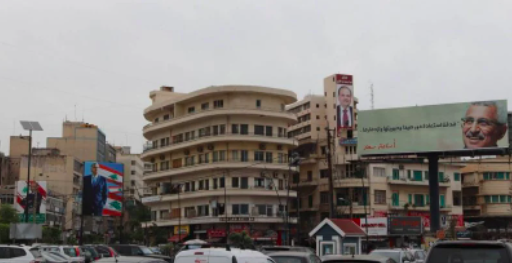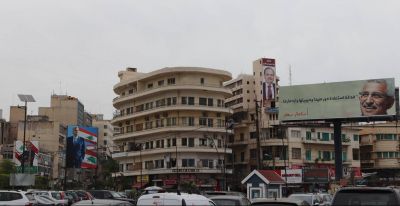
Election posters in Saida during the 2018 parliamentary elections. (Credit: L'Orient Today / Archive)
It was not enough for the South I (Saida-Jezzine) constituency to be the only constituency lacking geographical continuity. This constituency, which consists of the city of Saida, which was detached from the Zahrani area, and the Jezzine district, will witness two separate electoral battles in May, as the protagonists on both sides failed to form strong alliances between the candidates running in the two areas, unlike in the 2018 election.
In Saida, the hometown of the house of Hariri, the battle rages in the absence of the Future Movement, while Ousama Saad’s split from the March 8 coalition is permanent.
In Jezzine, where the Shiite electorate is a deciding minority, the traditional FPM-Amal rivalry persists, despite Hezbollah’s mediation efforts in the face of the Aounists’ presumed decline in popularity.
The concerned parties
There are more lists than seats in the South I constituency, where seven registered lists compete for five seats. The first was formed through an alliance between, on the one hand, Ousama Saad, head of the Popular Nasserite Organization (9,880 votes in 2018), a heavyweight leftist in Saida’s political landscape, and the independent Abdel Rahman Bizri, a prominent physician in the battle against COVID-19, and former mayor of the city (3,509 votes in 2018). Independent figures from Jezzine are part of this list.
Parliament Speaker Nabih Berri’s Amal Movement, with a large Shiite minority in the constituency, presented a list centered around Jezzine’s outgoing Maronite MP Ibrahim Azar (11,663 votes).
Gebran Bassil’s Free Patriotic Movement is running the same candidates in Jezzine as it did in 2018, in an alliance with independent figures from Saida.
As for Samir Geagea’s Lebanese Forces, they are allied with Yousef Naqib, former head of the Future Movement’s electoral machine in Saida.
At last, the protest movement is once again split into three lists.
From 2018 to 2022
Much has changed in four years. After the Oct. 17 protest movement, the economic crisis and the withdrawal of Saad Hariri from politics, the political landscape in Saida-Jezzine has undergone a profound reset.
In 2018, the Future Movement-backed list had obtained 16,470 votes, including 13,739 votes for Bahia Hariri, which allowed the Future baroness to be positioned at the top of the podium in Saida, although she was the only one elected from her list.
The withdrawal of the Future movement from politics has radically changed the situation in the country’s third city.
Yousef Naqib formed a list, supported by the LF and former Prime Minister Fouad Siniora.
Another change, but not the least, is the end of the alliance between Ousama Saad and the two Shiite parties. Following the Oct.17 protest movement, Saad positioned himself as the standard-bearer of popular will, breaking with his former allies in the March 8 camp.
As a result, Ousama Saad and Ibrahim Azar are running on separate lists this time. In 2018, their joint list obtained 22,083 votes, which was enough for two candidates to be elected MPs.
The FPM is also deprived of a Sunni ally of significant weight. In 2018, Michel Aoun’s party allied with Bassam Hammoud (Al-Jamaa al-Islamiya, 3,204 votes) and Abdel Rahman Bizri in Saida.
While these alliances allowed the orange party to win some 7,000 votes and to have two MPs, it will have to run without them this time, as Al-Jamaa al-Islamiya has chosen not to participate in the elections and Bizri has joined forces with Ousama Saad.
The FPM has allied with Mohammad Kawwas, a former official of the pro-Syrian Baath in Saida, and Ali Sadek Ammar, a figure of the Islamist movement in the city.
Civil society did not have a list in the 2018 elections in Saida, but three lists close to the protest movement have registered to participate in the May electoral battle.
The main issues
The second Sunni seat: Saida is gearing for a fierce battle, particularly since the absence of Bahia Hariri makes the political arena more competitive.
For his part, Ousama Saad should not have much difficulty in maintaining his seat, due to his large pool of votes. However, unlike in 2018, Saad will not be able to count on the votes of the Amal-Hezbollah tandem (the Shiites represent some 11 percent of the electorate in Saida).
According to a study by the Lebanese Center for Policy Studies, 13 percent of the preferential votes given to Ousama Saad in 2018, or nearly 1,500 votes, came from predominantly Shiite polling stations. But he should not have any trouble in re-securing his seat due to the possible drop in the electoral threshold ensuing from the Hariris’ withdrawal.
The real issue is the second Sunni seat, held since 1992 by Bahia Hariri. With his alliance with Ousama Saad, Abdel Rahman Bizri seems to be in a good position to inherit this seat, provided that the list obtains two electoral thresholds.
Youssef Naqib is also a serious candidate for the second Sunni seat in Saida, who can capitalize on his experience in organizing elections with the Future Movement (even if he does not have Bahia Hariri’s support in this electoral battle) and on the support of Fouad Siniora.
Naqib is allied with the LF, whose candidate in 2018, Ajaj Haddad (Jezzine), obtained 4,394 votes. However, this alliance could be a thorn in Naqib’s side, as the LF is viewed negatively by part of the electorate in Saida.
Recently, posters were hung in Saida’s streets accusing Samir Geagea’s party of having committed several war crimes in the 1980s. The checkered relations between Future and the LF may also be detrimental to this list.
In this battle, Al-Jamaa al-Islamiya could be in a position to serve as kingmaker. With some 3,500 votes in 2018, the moderate Islamist group could support one of the candidates in the race in exchange for an agreement on municipal elections, which have been postponed until 2023.
As for the groups that are close to the protest movement, although Saida was at the heart of the Oct. 17 uprising, it seems that they have little chance of having a Sunni candidate elected. These groups are divided into three lists in this constituency, which has the highest electoral threshold in the country.
The battle in Jezzine: The electoral battle for the Christian seats is likely to be particularly tough. Without a strong ally in Saida, the FPM (about 13,000 votes in Jezzine), Amal (11,000 votes) and the LF (4,000 votes) will have to rely mainly on themselves in Jezzine if they hope to exceed the electoral threshold.
Indeed, none of these three parties obtained in 2018 a score that would guarantee them a comfortable position in May. The FPM, which is perceived as a party that is losing momentum, is therefore likely to lose its second MP. Is it an opportunity for the Amal movement, which is the FPM’s great rival?
In the 2009 legislative elections, Aoun, then head of the FPM, managed to beat Berri, who considers Jezzine as his stronghold, by winning the Greek-Catholic seat (Issam Sawaya) and the two Maronite seats, then held by Ziad Aswad and Michel Helou, who has since died.
In the 2018 elections, the Amal movement got its revenge by winning one of the two Maronite seats. It was Ibrahim Azar, son of Samir Azar, a long-time ally of Berri, who was elected.
In 2018, the FPM candidate, Salim Khoury, was elected for the Greek-Catholic seat in Jezzine with only 708 votes. This tally does not allow him to be certain that he will be re-elected against the candidate supported by the Shiite leader.
The FPM list is further weakened by deep internal divisions, due to the existing rivalry between the two Maronite candidates Ziad Aswad (7,270 votes) and Amal Abou Zeid (5,016 votes). The day before the deadline to form electoral lists, a bitter exchange between these two candidates almost caused a breakup of the list.
Aswad also has checkered relationships with FPM head Gebran Bassil. Shortly before the formation of the lists, there was indeed talk within the Aounist movement of sidelining Aswad, who is reviled by Berri.
The FPM’s objective was to form a unified list with the Amal movement, as Hezbollah wanted, which is decisive in this district where the Shiite electorate (22 percent) has considerable weight.
Yet, sidelining Aswad, who has a certain popularity in the district, would have cost the FPM dearly. What was Hezbollah’s role in this battle amongst its allies? The LCPS survey indicates that 94 percent of voters at predominantly Shiite polling stations in Jezzine gave their preference vote to Ibrahim Azar, compared to only 5 percent for Amal Abu Zeid. The balance was thus tilted in favor of Amal at the expense of the FPM...
Datasheet
Two districts: Saida (the city) and Jezzine.
Five seats to be filled: two Sunni in Saida, two Maronites and one Greek-Catholic in Jezzine.
Number of registered voters: 129,317, including 8,333 expatriates.
Voters’ sectarian distribution: 44 percent Sunni, 28 percent Maronite, 16 percent Shia, 8 percent Greek Catholic, 1 percent Greek Orthodox, 1 percent Druze, 2 percent other (according to Interior Ministry figures).
Electoral threshold (in 2018): 20 percent of votes, or 13,148 votes.
Competing lists
1. Together for Saida and Jezzine: Free Patriotic Movement + independents
Amal Abou Zeid, Ziad Aswad, Salim Khoury, Mohammad Kawwas, Ali Sadek Ammar.
2. Capable: Citizens in a State (by Charbel Nahas)
Ahmad Assi, Élie Aboutas, Emilio Matar, Ismail Haffouda.
3. Moderation is our Strength: Amal movement
Youssef Skaff, Ibrahim Azar, Nabil Zaatari.
4. The Voice of Change: Independents
Joseph Mitri, Mohammad Taha, Rana Tawil.
5. We are the Change: protest movement groups
Robert Khoury, Sleiman Malek, Joseph Asmar, Hania Zaatari, Mohammad Zarif.
6. We Cote for Change: Ousama Saad + independents
Jamil Dagher, Charbel Massaad, Camille Serhal, Abderrahmane Bizri, Oussama Saad.
7. Our unity in Saida and Jezzine: Fouad Siniora + Lebanese Forces
Youssef Naqib, Wissam Tawil, Said Asmar, Ghada Ayoub.
This article was originally published in French in L'Orient-Le Jour.
